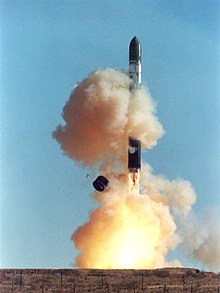Dnepr (rocket)
Dnepr [ ˈdnʲeːpʁ ] ( Russian Днепр , Ukrainian Дніпро; named after the Dnepr River ) is a Ukrainian launcher . It completed its first flight on April 15, 1988 and the provisionally last on March 26, 2015. There are only launch devices in Russia , and around 2017 the Russian government ended Russian participation in the Dnepr program.
history
The Dnepr is based on the largest ever built ICBM R-36M UTTH. More than 300 pieces of this type were manufactured by KB Juschnoje and Juschmasch in what is now Ukraine around 1988 . In the course of the START negotiations, the Soviet Union undertook to reduce the number of missiles to 58. Instead of destroying the ICBMs, however, they were converted into launch vehicles in the form of the Dnepr. That is why the Dnepr can be offered very cheaply on the market.
The initial launch was on April 21, 1999. By 2010 there had been seventeen launches with commercial payloads, sixteen of which were successful.
In May 2012, reports surfaced that the program could be discontinued due to unprofitability and high environmental risks. One can easily replace the Dnepr missiles with the more environmentally friendly Soyuz-2-1B or Angara models . As the continuation of the program was uncertain, a launch planned for 2012 with the Korean earth observation satellite KOMPSat 5 was rejected. The launch planned for September 2012, which was to take place with the Japanese weather satellite WNISat 1 , among others , was postponed due to delays on the part of the launcher.
In February 2013, the Ukrainian space agency announced eleven Dnepr missions for 2013, but only two were launched.
After the annexation of Crimea in 2014 , cooperation with Russia was reduced. Although the civil projects were not formally banned, the cooperation came to a standstill because of the uncertainty. In 2017, the manufacturing company was ready to manufacture all components for the first stage itself, but there are no more starting places available because the Russian government has ended its participation in the Dnepr program.
technology
The first two stages were taken over from the R-36M without modifications, the third stage was a MIRV bus, which only differs from the R-36M in a modified control system. Originally the bus was used to launch several warheads and decoys on different trajectories. Today, the Dnepr is therefore very well suited for exposing several small payloads on different tracks. The bus is necessary to bring the satellites into the correct orbit, but due to its high empty mass, the payload is lost. An additional upper level was planned for the Dnepr, but was not implemented. With such a stage, the payload could be increased significantly.
The three-tier Dnepr-1 is 34.3 m high, has a diameter of 3 m and weighs 210 t when fully fueled. As a fuel, asymmetrical dimethylhydrazine ( UDMH ) and dinitrogen tetroxide are used. The payload capacity in a 300 km high orbit at the launch from Baikonur was 3700 kg, making the rocket stronger than some pure space rockets. Like the R-36M, the Dnepr is launched from a missile silo , with three silos available at the Baikonur Cosmodrome . From 2006 to 2015 the active missile base Dombarowski ( Cosmodrome Jasny ) in southern Russia was also used for civil launches.
Others
The commercial provider of the missile is the Ukrainian company ISC Kosmotras . According to Kosmotras, there were around 150 stored R-36M ICBMs around 2010 that could be converted into Dnepr launch vehicles. The R-36M UTTH (SS-18 Mod 4) was used as Dnepr , but the R-36M2 (SS-18 Mod 5) was also considered for later launches. The start-up costs were given as 30 million US dollars (22 million euros).
See also
Web links
- Dnepr at russianspaceweb.com (english)
- Dnepr by Bernd Leitenberger
- ISC Kosmotras, the commercial provider of the Dnepr rocket (English)
- Dnepr in the Encyclopedia Astronautica (English)
Individual evidence
- ^ Rideshare launch by SpaceX serves commercial and scientific customers. In: Spaceflight Now. May 22, 2018, accessed March 11, 2019 .
- ^ A b Eugen Reichl: Type compass launchers . 1st edition. Motorbuch Verlag, Stuttgart 2011, ISBN 978-3-613-03269-9 .
- ^ Dnepr military program could be stopped soon . kyivpost.com, May 22, 2012, accessed February 22, 2013
- ↑ Kazkosmos looks forward to extension of the Dnepr program . kyivpost.com, June 21, 2012, accessed February 22, 2013
- ^ Anatoly Zak, George H. Chambers, S. Günes: Space exploration in 2013 . russianspaceweb.com as of February 18, 2013, accessed on February 22, 2013
- ^ Japanese meteorological firm to launch satellite to track Arctic sea ice. RIA Novosti, September 15, 2011, accessed September 16, 2011 .
- ↑ axelspace.com: News ( Memento of the original from January 19, 2013 in the Internet Archive ) Info: The archive link was inserted automatically and has not yet been checked. Please check the original and archive link according to the instructions and then remove this notice. . September 28, 2012, accessed February 22, 2013
- ↑ 11 Ukraine-produced booster rockets to be launched in 2013 ( Memento from April 18, 2013 in the web archive archive.today )
- ↑ Gunter Krebs: Dnepr. In: Gunter's Space Page. November 6, 2014, accessed November 6, 2014 .
- ^ "Rocket City" is looking for a new orbit , NZZ, May 6, 2017, page 35
- ^ Rideshare launch by SpaceX serves commercial and scientific customers. In: Spaceflight Now. May 22, 2018, accessed March 11, 2019 .
- ↑ FliegerRevue April 2010, pp. 38–41, The surveyor of the ice worlds

